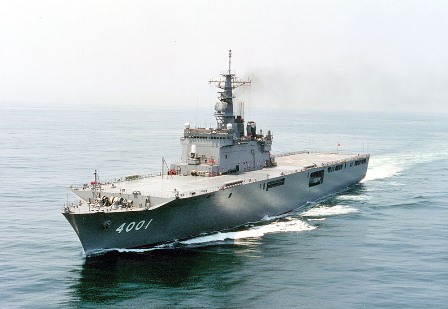Osumi-class
Summary
| Origin country | 🇯🇵 Japan |
| Category | Aircraft carrier |
| Subtype | Assault helicopter carrier |
| Manufacturer | Mitsui, Tamano, Hitachi, Maizuru |
| Year commissioned | 1998 |
| Units | 4001 OSUMI, 4002 SHIMOKITA, 4003 KUNISAKI |
Description
The Ōsumi class, also known as the Oosumi class, represents a class of tank landing ships utilized by the Japan Maritime Self-Defense Force (JMSDF). Although officially classified as tank landing ships (LSTs), these vessels do not possess the traditional bow doors and beaching capabilities associated with LSTs. They are more functionally similar to dock landing ships (LSDs), due in part to their well deck.
Originally proposed as small aircraft carriers for defensive and mine countermeasures roles, political considerations at the time led to their reclassification as amphibious transport vessels. With the introduction of the Hyūga-class helicopter carriers, JMSDF revisited the original carrier concept. The Ōsumi-class vessels stand out with their flat-top upper-vehicle parking decks and starboard offset superstructures, giving the impression of small aircraft carriers. Despite having helicopter flight decks at the stern, these ships are not equipped with an enclosed hangar, requiring helicopters to be secured on the upper deck. They have deck elevators suited for vehicle transport to the lower deck with access to the well deck. The hull features armored sections and includes a landing deck capable of supporting two large CH-47 helicopters, as well as housing two Landing Craft Air Cushion (LCAC) hovercraft. While there are storage spaces for vehicles below the forward main deck, they are inaccessible for larger aircraft due to elevator size limitations.
As part of the JMSDF's Maritime Operational Transport concept developed in the mid-1990s, the Ōsumi-class ships serve to reinforce units in areas where enemy landings are possible, probable, or have occurred within Japanese territory. Instead of amphibious assaults abroad, this operational doctrine focuses on troop transport, equipment delivery, and humanitarian assistance within Japan. To enhance their amphibious capabilities, the vessels have been refitted to embark MV-22 Osprey tiltrotor aircraft and AAV7 amphibious vehicles.
Throughout their service history, Ōsumi-class ships, including the Ōsumi and Kunisaki, have participated in disaster relief operations, notably during the 2011 Tōhoku earthquake and tsunami. Planned upgrades include enhancing their capacity for amphibious operations, although these ships currently offer moderate lift capability and support for outer island defense. Discussions take place about acquiring a more capable amphibious assault ship from the United States, such as the Wasp-class.
Technical specifications
| Displacement | 11600 tons |
| Crew | 137 members |
| Width | 25.8 m (84.6 ft) |
| Length | 178.0 m (584.0 ft) |
| Propulsion | 2 Mitsui 16 V 42 diesels with a power of 26,000 hp each - 2 propellers |
| Armament | 2 CIWS Mk.15 Phalanx + 1 12.7mm machine gun |
| Maximum speed | 22 knots |
